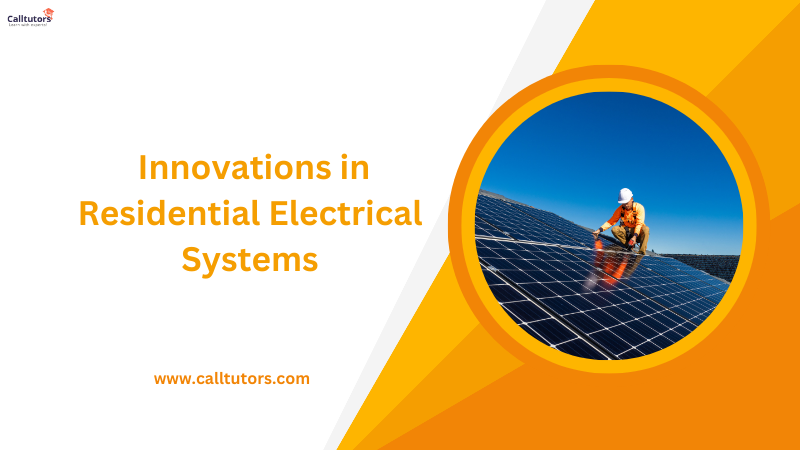
Innovations in Residential Electrical Systems
Introduction
In today’s ever-changing world of home technology, the phrase “Smart Homes, Smarter Engineers” perfectly captures the mutually beneficial partnership between innovative systems and the creative brains behind them. The story that emerges from this investigation of “Innovations in Residential Electrical Systems” is one in which homes are cleverly engineered rather than just powered. The story follows the development of smart lighting, the impact of the Internet of Things (IoT), increased security measures, home automation, energy efficiency solutions, and more, all of which are coming together to redefine what it means to live in a house in the modern era.
Note: If you are a student and struggling with your Electrical Engineering Homework , then you can get the best Electrical Engineering Homework Help from our experts.
What is Residential Electrical Systems?
The term “residential electrical system” describes the system of wires and components that provide electricity to houses. These systems are specifically designed to distribute energy to different appliances and electronics in a home in a way that is both safe and efficient.
Key components of residential electrical systems
Service Entrance
The point where electrical power from the utility company enters the home. This typically includes the main electrical panel, which houses circuit breakers or fuses to control and protect the electrical circuits.
Circuit Breakers or Fuses
Surge protectors cut power to the system in the event of an overload. These days, circuit breakers are standard in most home electrical systems.
Wiring
Conductive pathways that carry electricity throughout the home. Different types of wiring are used for various applications, such as lighting, outlets, and appliances.
Outlets and Switches
Things that regulate the current that goes to various electrical appliances, lights, and gadgets. Electrical outlets allow for the connection of various devices, while switches regulate the current that goes to various light fixtures.
Light Fixtures
Devices that house and control electric lamps for illumination. Modern residential electrical systems often incorporate smart lighting options with advanced controls.
Appliances
Various household devices and machines that use electricity for operation. This includes refrigerators, ovens, air conditioners, and other electrical appliances.
Grounding System
A safety mechanism that, in the case of a malfunction, lowers the danger of electrical shock and fire by sending the faulty electricity underground.
Service Disconnect
A switch that allows residents or electricians to disconnect the home’s electrical system from the utility grid for maintenance or emergency purposes.
Innovations in Residential Electrical Systems
Home automation is the controlled and automated operation of a home’s electrical systems, lighting, climate control, security, and entertainment systems via the use of a network of interconnected smart devices and systems. Being able to remotely monitor and operate home systems brings about increased convenience, energy efficiency, and security.
Energy-Efficient Lighting
Swap out your old incandescent light bulbs with these more eco-friendly LEDs. Residents can schedule, change the color, and regulate the brightness of their smart lights. Enhanced comfort and ambiance with lower energy usage, extended bulb life, and programmable lighting.
Solar Power Integration
Rooftop solar panel installation is a method of converting solar energy into usable power. Using less power from the grid, saving money, and reducing environmental impact.
Smart Meters and Energy Monitoring
The installation of smart meters that track energy use in real-time. Power consumption trends may be uncovered with the use of energy monitoring systems. Gains in energy efficiency, insight into power use, and the capacity to make educated choices that save money.
Advanced Home Security Systems
Utilization of advanced security technologies, including smart cameras, motion sensors, door/window sensors, and biometric access control. Enhanced home security, remote monitoring capabilities, and immediate alerts in the event of suspicious activities.
Battery Storage Solutions
Putting in place residential energy storage systems that employ lithium-ion batteries to store extra power from solar panels for when the sun doesn’t shine. Power backup during outages, energy efficiency, and increased self-sufficiency.
Electric Vehicle Charging Infrastructure
Installation of home charging stations to support the charging of electric vehicles, fostering the adoption of cleaner transportation. Convenient charging at home, encouragement of electric vehicle adoption, and reduced reliance on traditional fuel sources.
Integrated Home Networks
Establishment of comprehensive home networks to support the increasing number of connected devices, ensuring efficient communication and data transfer. Seamless connectivity for smart devices, improved internet speed, and enhanced reliability of home networks.
Conclusion
In conclusion, the innovations in residential electrical systems represent a transformative shift towards smarter, more efficient, and sustainable living. The integration of smart home automation, energy-efficient lighting, solar power, and advanced security measures reflects a commitment to enhancing convenience, safety, and environmental responsibility. The advent of technologies like smart meters, energy storage solutions, and electric vehicle charging infrastructure further propels homes into the future, promoting self-sufficiency and reduced reliance on traditional energy sources. The interconnectedness facilitated by integrated home networks and advanced wiring systems underscores a commitment to seamless connectivity and adaptability to evolving technological landscapes.


